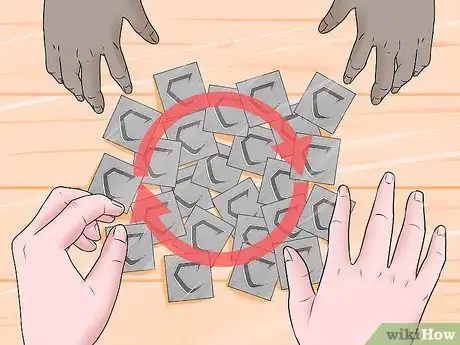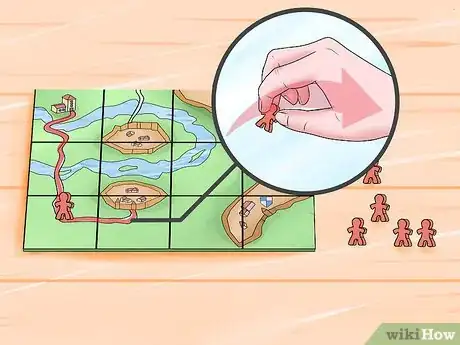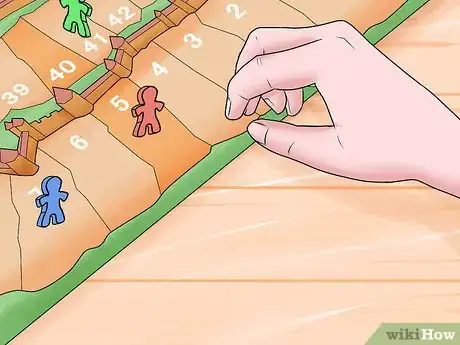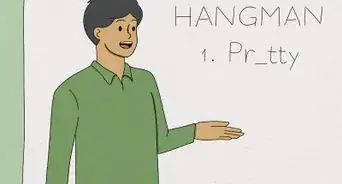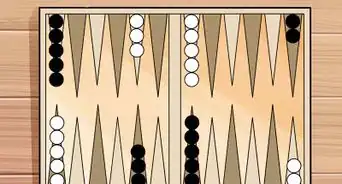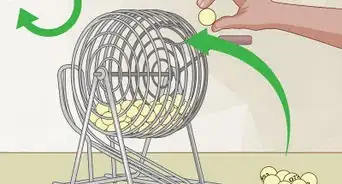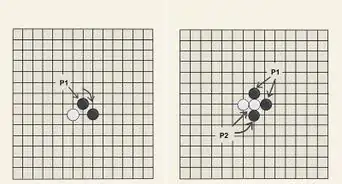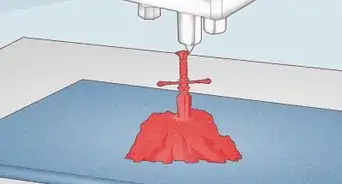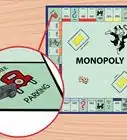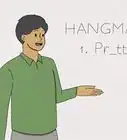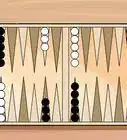wikiHow is a “wiki,” similar to Wikipedia, which means that many of our articles are co-written by multiple authors. To create this article, volunteer authors worked to edit and improve it over time.
This article has been viewed 99,518 times.
Learn more...
Carcassonne is a popular board game which won the prestigious Spiel des Jahres in 2001. The goal is to score points by owning completed features (city, cloister, farm or road) or incomplete features. While the game may seem confusing at first, it is actually quite easy to learn.
Steps
Starting the Game
-
1Understand the object of the game. To play Carcassonne, you and your fellow players will place tiles to build cities, farms, roads and cloisters. As you do so, you will gain points. The winner of Carcassonne is the player who has the most points when all of the game tiles have been used.[1]
-
2Place the starting tile. Every game of Carcassonne begins by placing the starting tile in the center of your playing space. The back of this tile looks different from all of the rest of the tiles, so it should be easy to find.[2]
- Use a large table or other playing space to play Carcassonne because the tiles will sprawl out quite a bit.
Advertisement -
3Prepare the scorecard. To start the game, every player puts one meeple on the scorecard. As the game progresses and players earn points, they will move their meeples to indicate how many points they have. Each player is responsible for his or her own points.[3]
-
4Shuffle and place the remaining tiles face down. Players will need to draw tiles at random to place them on the board and continue to expand it. Therefore, it is a good idea to shuffle the tiles and place them in a few piles around the playing space. Or, if you have a cloth bag, you can use it to hold the tiles and have players draw from the bag without looking.[4]
-
5Decide who will go first. You can choose the first player at random, have the youngest player go first, or have the person who won the last game you played go first. The first player should begin the game by drawing a tile at random and placing it next to the starting tile so that their features align.[5]
- Each tile has features on it that must align with each other when you place them. For example, some tiles have roads, while other have fields or cities. You must make sure that the tile you place matches up with the tile or tiles that it touches.
Placing Tiles and Meeples
-
1Continue to draw tiles and place them next to existing tiles. Play should pass to the left and each player should draw and place a tile next to an existing tile during his or her turn. Players should continue drawing and placing tiles until no tiles are left.[6]
- Make sure the edges of tile match the edges of any connecting tiles.
-
2Place a meeple on a tile you just laid. You may use your meeples to claim a road, farm, or city on a tile that you just laid down. You may not place meeples on another player’s previously placed tile. Before you place a meeple, make sure that the territory you will claim has not already been claimed by another player.[7]
- Place meeples standing up on roads, cities, and cloisters. If you want to claim a field, then you should lay the meeple on its back to indicate that it is a farmer. Farmers remain on the board until the end of the game.
-
3Make sure that you place meeples on vacant territories only. You cannot place a meeple on a territory that has already been claimed by a fellow player. For example, you can't place a meeple if another player’s meeple is already on the same road/city/farm on connecting tiles.[8]
-
4Take back Meeples if you complete a road. If you complete a road by laying down a tile on your turn, then you can remove the meeple that is on that road, count up the tiles for the road, and add that number to your score. You can then return the meeple that you picked up back to your supply for reuse.[9]
Calculating Your Score and Finishing the Game
-
1Tally your score for each turn. When you score points, add them to your score card by moving your scoring meeple right away. Keep in mind that some scores cannot be tallied until the game is over. For example, farmers cannot be scored until the end of the game because their fields may keep expanding.[10]
- Add 1 point to your score for each road tile that connects to a road you have completed.
- Add 2 points to your score for every city you complete, plus an extra 2 points for any small shields that appear within your city.
-
2Keep playing until all of the tiles have been used. A game of Carcassonne is over when all of the tiles have been used up and placed. If at any point you draw a tile that you cannot place because it won’t fit anywhere, that tile is discarded and left out of the rest of the game.[11]
- If you decide that a tile cannot be played, make sure your fellow players agree that there is nowhere to place the tile. You cannot discard a tile because it would benefit your fellow players and not you. You must play it if it has a place on the board.
-
3Determine special scores. At the end of the game, you will need to add up your points for incomplete roads, cloisters, and farms. All of these things give you extra points that may help you to win the game. The player with the most points wins the game. Check to see if you have any of the following:[12]
- Incomplete Roads-add 1 point for every tile that is connected to an incomplete road that you own.
- Cloisters-add 9 points to your score if you have a complete cloister (if it is surrounded by tiles on all sides) and add 1 point per adjacent tile plus the cloister tile if you have an incomplete cloister (not surrounded by tiles).
- Farmers-add 3 points to your score for each farmer that has a city connected to its field. Add another 3 points if the farmer is the only farmer in that field.
Community Q&A
-
QuestionTo start, how many pieces are there in the base game?
 Community AnswerThe basic game is made of 72 tiles, including the starting one. Most starting boxes today include the river expansion, which adds 12 river tiles.
Community AnswerThe basic game is made of 72 tiles, including the starting one. Most starting boxes today include the river expansion, which adds 12 river tiles. -
QuestionWhat's the difference between gardens and fields?
 Tai SmithCommunity AnswerA garden grows flowers and stuff while a field is just a lot of grass. Garden = Grows Stuff, Field = Big Long Grassy Area.
Tai SmithCommunity AnswerA garden grows flowers and stuff while a field is just a lot of grass. Garden = Grows Stuff, Field = Big Long Grassy Area. -
QuestionCan tiles be placed upside down, e.g. a cloister tile?
 FredwinaCommunity AnswerYes. The tiles don't have to be right side up as long as they connect to the adjacent tile.
FredwinaCommunity AnswerYes. The tiles don't have to be right side up as long as they connect to the adjacent tile.
Things You'll Need
- A Carcassonne set
- People to play with you
References
- ↑ http://www.chessandpoker.com/carcassonne-rules-and-strategy-guide.html
- ↑ http://www.chessandpoker.com/carcassonne-rules-and-strategy-guide.html
- ↑ http://www.chessandpoker.com/carcassonne-rules-and-strategy-guide.html
- ↑ http://www.chessandpoker.com/carcassonne-rules-and-strategy-guide.html
- ↑ http://www.chessandpoker.com/carcassonne-rules-and-strategy-guide.html
- ↑ http://www.chessandpoker.com/carcassonne-rules-and-strategy-guide.html
- ↑ http://www.chessandpoker.com/carcassonne-rules-and-strategy-guide.html
- ↑ http://www.chessandpoker.com/carcassonne-rules-and-strategy-guide.html
- ↑ http://www.chessandpoker.com/carcassonne-rules-and-strategy-guide.html
About This Article
To play the popular board game Carcassonne, aim to have the most points once all of the game tiles have been used. At the start of your turn, draw a tile, place it next to an existing tile, and put a meeple on it to claim the territory. Once you complete an area, you can then remove your meeple, count up the tiles it took you to create the territory, and add this number to your scorecard. Keep playing until you've used all of the tiles. Finally, count up any final points, such as bonus points for connecting roads or for putting shields around cities. To learn how to use your meeples to help keep score during a game of Carcassonne, keep reading!



